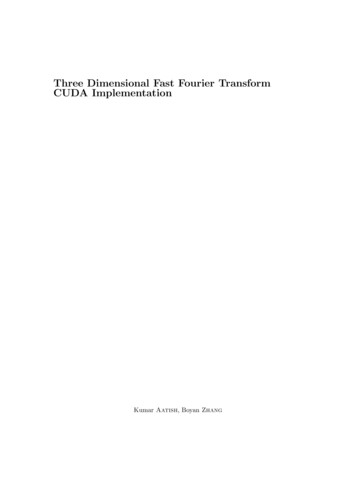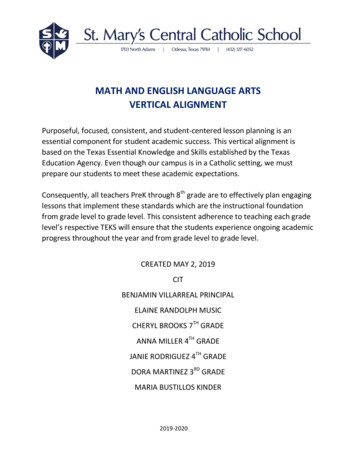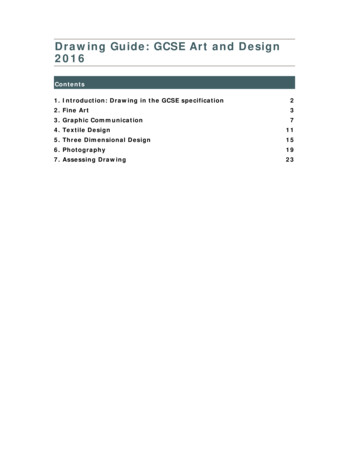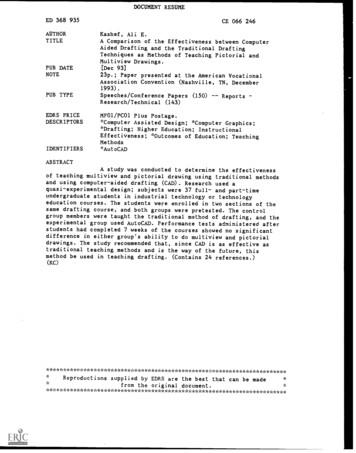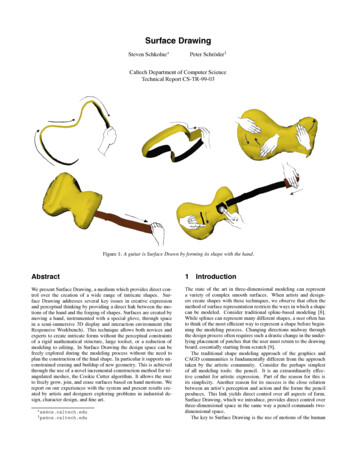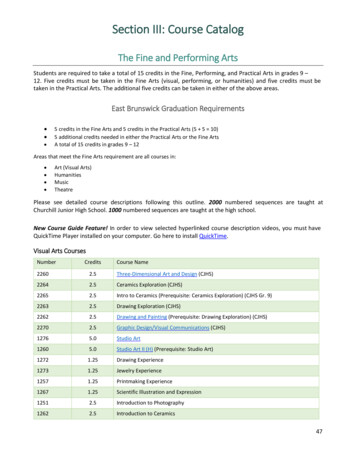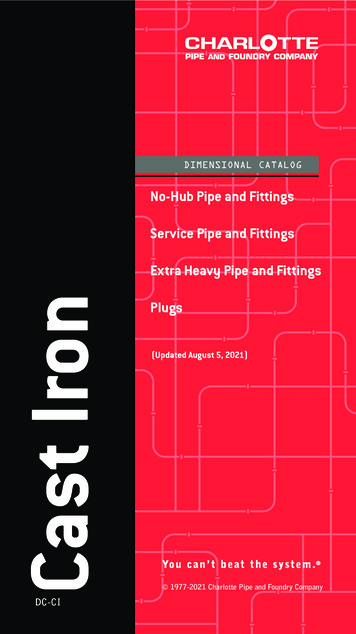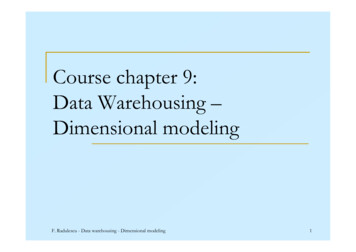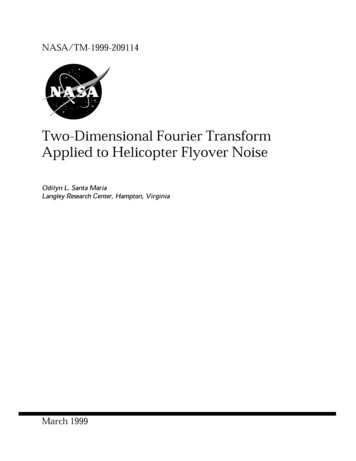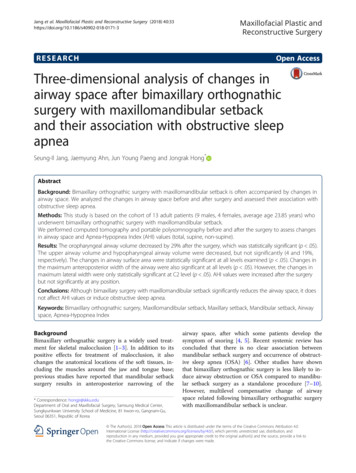
Transcription
Jang et al. Maxillofacial Plastic and Reconstructive Surgery (2018) llofacial Plastic andReconstructive SurgeryRESEARCHOpen AccessThree-dimensional analysis of changes inairway space after bimaxillary orthognathicsurgery with maxillomandibular setbackand their association with obstructive sleepapneaSeung-Il Jang, Jaemyung Ahn, Jun Young Paeng and Jongrak Hong*AbstractBackground: Bimaxillary orthognathic surgery with maxillomandibular setback is often accompanied by changes inairway space. We analyzed the changes in airway space before and after surgery and assessed their association withobstructive sleep apnea.Methods: This study is based on the cohort of 13 adult patients (9 males, 4 females, average age 23.85 years) whounderwent bimaxillary orthognathic surgery with maxillomandibular setback.We performed computed tomography and portable polysomnography before and after the surgery to assess changesin airway space and Apnea-Hypopnea Index (AHI) values (total, supine, non-supine).Results: The oropharyngeal airway volume decreased by 29% after the surgery, which was statistically significant (p .05).The upper airway volume and hypopharyngeal airway volume were decreased, but not significantly (4 and 19%,respectively). The changes in airway surface area were statistically significant at all levels examined (p .05). Changes inthe maximum anteroposterior width of the airway were also significant at all levels (p .05). However, the changes inmaximum lateral width were only statistically significant at C2 level (p .05). AHI values were increased after the surgerybut not significantly at any position.Conclusions: Although bimaxillary surgery with maxillomandibular setback significantly reduces the airway space, it doesnot affect AHI values or induce obstructive sleep apnea.Keywords: Bimaxillary orthognathic surgery, Maxillomandibular setback, Maxillary setback, Mandibular setback, Airwayspace, Apnea-Hypopnea IndexBackgroundBimaxillary orthognathic surgery is a widely used treatment for skeletal malocclusion [1–3]. In addition to itspositive effects for treatment of malocclusion, it alsochanges the anatomical locations of the soft tissues, including the muscles around the jaw and tongue base;previous studies have reported that mandibular setbacksurgery results in anteroposterior narrowing of the* Correspondence: hongjr@skku.eduDepartment of Oral and Maxillofacial Surgery, Samsung Medical Center,Sungkyunkwan University School of Medicine, 81 Irwon-ro, Gangnam-Gu,Seoul 06351, Republic of Koreaairway space, after which some patients develop thesymptom of snoring [4, 5]. Recent systemic review hasconcluded that there is no clear association betweenmandibular setback surgery and occurrence of obstructive sleep apnea (OSA) [6]. Other studies have shownthat bimaxillary orthognathic surgery is less likely to induce airway obstruction or OSA compared to mandibular setback surgery as a standalone procedure [7–10].However, multilevel compensative change of airwayspace related following bimaxillary orthognathic surgerywith maxillomandibular setback is unclear. The Author(s). 2018 Open Access This article is distributed under the terms of the Creative Commons Attribution 4.0International License (http://creativecommons.org/licenses/by/4.0/), which permits unrestricted use, distribution, andreproduction in any medium, provided you give appropriate credit to the original author(s) and the source, provide a link tothe Creative Commons license, and indicate if changes were made.
Jang et al. Maxillofacial Plastic and Reconstructive Surgery (2018) 40:33The purpose of this study was to assess the associationbetween changes in the airway space after the surgery andsubsequent OSA in patients who underwent bimaxillaryorthognathic surgery with maxillomandibular setback. Weperformed a three-dimensional analysis using computedtomography to improve on the traditional airway spaceparameters measured using a two-dimensional cephalometric analysis. In addition, we measured AHI values before and post-surgery through polysomnography, to assessthe relationship between the changes in airway space andAHI values.MethodsSubjectsThis study was based on 13 adult ( 18 years old) patientsdiagnosed with class III malocclusion and mandibularprognathism and treated with bimaxillary orthognathicsurgery with maxillomandibular setback at the Department of Oral-Maxillofacial Surgery at Samsung MedicalCenter, between July 2016 and October 2017.We did not consider the sex of the patient when determining inclusion or exclusion criteria, but excluded patients with underlying conditions such as systemicwasting disease, respiratory disease, or significant abnormalities in the airway space. And we calculated the BMIof the patients before the surgery and excluded patientswith BMI values 30 kg/m2, as well as patients withOSA (AHI 15 or AHI 5 with symptoms) confirmedwith polysomnography and Epworth Sleepiness ScaleQuestionnaire before the surgery. The study design wasapproved by the ethics review board (SMC 2018-06-04).Follow-upFollow-up time points were set before the surgery (T0) and7 months after the surgery (T1). All patients were imagedusing facial bone computed tomography (GE LightSpeedVCT XT; General Electronics Medical Systems, Milwaukee,WI, USA) on T0 and T1. All patients were admitted theday before the surgery and underwent polysomnographywith a portable polysomnograph (Stardust II; KoninklijkePhilips Electronics N.V. of the Netherlands). At T1, the patients were provided with the polysomnography equipmentand performed polysomnography again at home.Surgery proceduresIntermediate wafer was produced by model surgery, anda Le Fort I osteotomy was performed. The maxilla wasrepositioned according to the surgical plan, using theintermediate wafer, and was fixed semi-rigidly using aplate and screws. We then performed bilateral sagittalsplit ramus osteotomy and repositioned the distal segment to the pre-fixed maxilla, using the final wafer.There were no serious complications for the patientseither before or after the surgery.Page 2 of 11Radiographic evaluationComputed tomographyThe patients were imaged using panoramic radiography,cephalometric radiography (posteroanterior skull projection and lateral skull projection), and facial bone computed tomography (GE LightSpeed VCT XT; GeneralElectronics Medical Systems, Milwaukee, WI, USA), onT0 and T1. We assessed the changes in the jawbone andairway space resulting from surgery. All radiographs weretaken after ensuring centric occlusion of the teeth and removal of lower lip tension. We educated the patients onthe correct postures needed for radiography, and the patients were in a supine position for facial bone computedtomography. The computed tomography data were savedin Digital Imaging and Communication in Medicine(DICOM) form, reconstituted using Invivo 5 (AnatomageInc., San Jose, CA, USA), and analyzed in coronal, sagittal,horizontal view, and 3D reconstruction views. Using thethree-dimensional reconstruction view, as reconstitutedby the patient orientation function of Invivo 5, we set theFrankfort horizontal plane (FH plane, created from the orbital of both sides and right porion) and midsagittal plane(a plane that is perpendicular to the FH plane and passesthrough the nasion and A point) and set the head postureto be parallel with the FH plane, using the reoriented midsagittal plane as the standard. A two-dimensional image(cross section at the midsagittal plane) was used as the lateral skull view (Lat View) (Fig. 1).Landmarks and measurementWe defined landmarks using the Lat View. The lowermost protruding parts of cervical vertebrae 1, 2, and 3 (asshown in the Lat View) were defined as the standardpoints C1, C2, and C3. The planes parallel to the FH planeand crossing C1, C2, and C3 were defined as the C1-FHplane (C1-F), C2-FH plane (C2-F), and C3-FH plane(C3-F), respectively. The airway space above the C1-Fplane is defined as the upper airway, and the airway spacebetween C1-F plane and C3-F plane is defined as thelower airway. The upper airway and the lower airway arecombined to define the total airway. The airway space between C1-F and C2-F was defined as the oropharyngealairway, and the airway space between C2-F and C3-F wasdefined as the hypopharyngeal airway (Fig. 2).If an assessment of changes at an identical position frombefore to after the surgery (that is, from T0 to T1) was required, we used the superimposition module of Invivo 5,overlaying the CT scans from T0 and T1 on the same location and plane of the skull base layer. The airway measurement function of Invivo 5 allowed measurements oftotal airway volume, upper airway volume, and lower airway volume (oropharyngeal airway volume, hypopharyngeal airway volume) before and after the surgery (Fig. 1).We measured the maximum anteroposterior width
Jang et al. Maxillofacial Plastic and Reconstructive Surgery (2018) 40:33Page 3 of 11Fig. 1 DICOM file is reconstructed into four basic views. a Horizontal view: In this plane, the area, maximum lateral width and maximum anteroposteriorwidth of the airway parameters were measured. b Sagittal view (lateral skull view). c Coronal view. d 3D Reconstruction view: The three-dimensional formand volume of airway space are shown(C1AP, C2AP, C3AP), maximum lateral width (C1LW,C2LW, C3LW), and the corresponding cross-sectionalareas (C1A, C2A, C3A) at the cross section where theC1-F, C2-F, and C3-F planes passed through the airwayspace, for T0 and T1. Using a Lat View of the overlaid CTscans, we defined the perpendicular distance to the FHplane between the posterior nasal spines (PNS) before andafter the surgery as the amount of posterior impaction.The distance between the incisor tips as in parallel withthe FH plane was defined as the maxillary setback. In thesame way, the distance between the mentons was definedas the mandibular setback (Fig. 3).Polysomnography evaluationAll patients underwent polysomnography after being admitted on the day before the surgery. The patients completed a survey for polysomnography before the test.Height and weight information obtained from the surveywere used to calculate the BMI of the patients.After the surgery, the patients took the portable polysomnography equipment (Stardust II; Koninklijke PhilipsElectronics N.V. of the Netherland) home and performed the test again on T1.Information on heart rate, beats per minute, SpO2, centralapnea, obstructive apnea, mixed apnea, hypopnea, snoring,and sleep posture was recorded during the test. Data fromthe equipment were validated and modified (if needed) by asingle technologist. AHI values (total, supine, non-supine)and lowest SpO2 were used in this study (Fig. 4).Variables and statistical analysisWe performed statistical analyses of each parameter beforeand after the surgery using IBM SPSS Statistics (version23.0). Changes in the parameters of airway space (total,upper, lower, oropharyngeal, and hypopharyngeal airwayvolumes, C1AP, C2AP, C3AP, C1LW, C2LW, C3LW, C1A,C2A, C3A) and the polysomnography parameters (total, supine, non-supine AHI, lowest SpO2) before and after thesurgery were assessed for statistical significance using thepaired t test or Wilcoxson’s signed rank test (with significance level α 0.05). Furthermore, the relationship betweenthe airway space parameters (oropharyngeal, hypopharyngeal and upper airway volumes, C1AP, C2AP, C3AP,C1LW, C2LW, C3LW, C1A, C2A, C3A) and the amountof mandibular setback, maxillary setback, and posterior impaction was assessed via Spearman’s correlation analysis.Results and discussionThe average age of the patients in this study was23.92 years; of the 13 patients, 9 patients were malesand 4 were females. The average pre-surgery BMI was24.86 2.48 kg/m2 (Table 1), and none of the patientsexhibited underlying OSA prior to the surgery (12 patients had AHI 5 and 1 patient had an AHI of 5.1;none of the patients had systemic disorders or daytime
Jang et al. Maxillofacial Plastic and Reconstructive Surgery (2018) 40:33Page 4 of 11Fig. 2 Landmarks and reference plane of total airway space. C1, C2, and C3: The lower most protruding parts of cervical vertebrae 1, 2, and 3.C1-F, C2-F, and C3-F: Planes parallel to FH plane and through C1, C2, and C3. Oropharyngeal airway: The airway space between C1-F and C2-F.Hypopharyngeal airway: The airway space between C2-F and C3-FFig. 3 a. Measurements of preoperative and postoperative airway parameter changes using Invivo 5 superimposition module. Posteriorimpaction: The perpendicular distance to the FH plane between the posterior nasal spines (PNS) before and after surgery. Maxillary setback:The horizontal distance between the incisor tips as in parallel with the FH plane. Mandibular setback: The horizontal distance betweenmentons as in parallel with the FH plane. The maximum anteroposterior width (C1AP, C2AP, C3AP), b. maximum lateral width (C1LW, C2LW,C3LW), and the area of the cross section (C1A, C2A, C3A) on the horizontal view at C1, C2, and C3 level were measured, respectively
Jang et al. Maxillofacial Plastic and Reconstructive Surgery (2018) 40:33Page 5 of 11Airway parametersThe average values of the airway space parameters(C1AP, C2AP, C3AP, C1LW, C2LW, C3LW, C1A, C2A,and C3A; the upper airway volume; lower airway volume; and oropharyngeal airway volume; and hypopharyngeal airway volume) measured before and after thesurgery (on T0 and T1) are shown in Table 2.The oropharyngeal airway volume was reduced by 29%after the surgery, which was statistically significant. Theupper airway volume was reduced by 4%, and hypopharyngeal airway volume was reduced by 19% but notsignificantly.We compared the maximum anteroposterior length,lateral width, and the area of the cross section of the airway space at the C1, C2, and C3 levels before and afterthe surgery (T0 and T1). At the C1 and C2 level, themaximum anteroposterior width (C1AP and C2AP) andthe surface area (C1A and C2A), the maximum lateralwidth of C2(C2LW) showed statistically significant reductions. However, the C1LW showed not statisticallysignificant reduction. At the C3 Level, C3AP and C3Ashowed statistically significant reductions. However, thedifference of the C3LW was not statistically significant.PolysomnographyFig. 4 Analysis of polysomnography. While the patient was sleeping,heart rate, beats per minute, SpO2, central apnea, obstructive apnea,mixed apnea, hypopnea, snoring, and sleep posture were recordedsleepiness). The average post-surgery (T1) BMI was24.54 2.19 kg/m2, and the difference of the BMI wasnot statistically significant (Table 1).The average amount of mandibular setback at the timeof the surgery was 10.15 3.27 mm, and the averageamount of maxillary posterior impaction was 3.91 1.68 mm from the posterior nasal spine (PNS). Theaverage amount of maxillary setback was 1.53 1.05 mmtoward the posterior end (Table 1).The average values of the polysomnographic data are shownin (Table 3). The average values of the AHI (total) and AHI(supine) increased by 2.51 and 2.92, respectively, after thesurgery. The average value of the AHI (non-supine) decreased by 0.54 after the surgery. But all these values werenot statistically significant. The average values of the lowestSpO2 changed a little after the surgery. Details of the datafor each patient (on T0 and T1) are shown in Table 5.DiscussionMaxillomandibular setback causes narrowing of the airway space. On the contrary, maxillomandibular advancement returns the narrowed airway structure to a normalstate, which consequently relieves the symptoms ofTable 1 General characteristics of subjectsNumber of Subjects (Male/Female)13 (9/4)Age (Years)23.92 5.15 (21 – 38)BMI (Kg/m2)(T0)24.86 2.45 (21.61 – 29.86)(T1)24.54 2.19 (22.04 – 28.74)p 0.05(Paired t-test)Maxillary setback(mm)1.53 1.05 (0 – 3.11)Posterior Impaction(mm)3.91 1.68 (0 – 6.68)Mandibular setback(mm)10.15 3.27 (3.85 – 15.79)T0 before surgery, T1 7 months after surgeryData are shown as mean SD (range)
Jang et al. Maxillofacial Plastic and Reconstructive Surgery (2018) 40:33Table 2 Morphologic change of the airway spaceT0MeanT1MeanC1AP*13.15 4.5610.11 3.69C2AP*13.95 4.3610.99 3.85C3AP*14.63 3.5012.29 4.92C1LW23.28 4.6320.38 4.38C2LW*27.52 6.7024.13 4.31C3LW31.86 7.4427.76 8.50C1A*237.79 79.37167.68 67.05C2A*290.04 128.14209.87 84.74C3A*283.51 80.07219.92 84.11Upper airway6.95 2.806.70 2.27Lower airway*9.01 2.716.78 1.87Oropharyngeal airway*4.87 1.803.48 0.92Hypopharyngeal airway3.98 1.343.21 1.28Total airway15.95 4.8213.48 3.54Length (mm)2Area (mm )3Volume (mm )T0 before surgery, T1 7 months after surgery*p 0.05 (paired t-test, Wilcoxon s signed rank test)Data are shown as mean SD (range).OSA. Vigneron et al. [11] performed maxillomandibularadvancement surgery (MMA) on OSA patients and obtained a 50–80% reduction in AHI values after the surgery. Another study by Varghese et al. [12] showed an83% reduction in AHI value 6.7 months after the surgery. These results suggest that MMA can significantlyPage 6 of 11reduce the AHI value, and therefore, it may be considered that maxillomandibular setback surgery could significantly increase the AHI value.We performed a three-dimensional analysis of thechanges in airway space after the maxillomandibular setback surgery, and all patients underwent polysomnography, to assess not only the changes in airway space butalso the association between the changes in airway spaceand the AHI value. The results of this study demonstrated a decrease in all airway space parameters afterthe surgery (Table 2). However, no significant increasewas observed in AHI values in all positions (total, supine, non-supine) (Table 4).There is an ongoing debate on the occurrence of OSAafter bimaxillary orthognathic surgery [13].In the study by Gokce et al. [4], nasopharyngeal, retropalatal dimension, and the volume of the superiorpharyngeal airway space increased due to the maxillaryadvancement. However, the anteroposterior width andthe volume of the oropharyngeal, hypopharyngeal spacedecreased after the bimaxillary orthognathic surgery dueto the mandibular setback. Total airway volume has increased, and the AHI value decreased after the surgery.The average maxillary advancement and mandibular setback in the study by Gokce et al. [4] were 5 2.2 mmand 6.5 2.7 mm, respectively.In contrast, the study by Lee et al. [14] showed adecrease in airway space and increase in AHI afterbimaxillary orthognathic surgery, with the average maxillary setback and mandibular setback of 1.01 1.54 mmand 8.23 3.59 mm, respectively. The difference betweenthese studies is thought to come from the difference inTable 3 the relationship between the airway space parameters and the amount of jaw movementMandibular setbackMaxillary setbackPosterior impactionOropharyngeal airway0.24660.76020.2079Hypopharyngeal airway0.70740.95710.7339Upper 97160.45680.9289Volume (mm3)Length (mm)2Area (mm )*p 0.05 (Spearman s correlation analysis)
Jang et al. Maxillofacial Plastic and Reconstructive Surgery (2018) 40:33Table 4 Polysomnographic dataT0T1AHI (total)2.24 1.244.75 5.91AHI (supine)2.45 1.485.37 6.31AHI (non-supine)1.55 1.811.01 1.53Lowest oxygen saturation93.92 2.6093.38 5.36p 0.05(Paired t-test)T0 before surgery, T1 7 months after surgeryData are shown as mean SD (range)maxillary movement (5 2.2 mm and 1.01 mm) despite a similar mandibular setback amount.This also suggests that maxillary advancement canimprove the condition of reduced airway space causedby mandibular setback. Thus, the maxillary advancement can improve the OSA. The meta-analysis of related studies by He J et al. [9] further supports thisobservation. In this study, no statistically significantdecrease in the upper airway volume was observedafter combined therapy of mandibular setback andmaxillary advancement. However, statistically significant differences in the nasopharyngeal airway volumeand upper air way volume were observed when compared to mandibular setback surgery alone. However,no statistically meaningful variations existed in thevolume of the oropharynx and hypopharynx comparedto mandibular setback surgery alone.Kim et al. [15] reported that the direction and amountof maxillary movement has a significant effect on thechanges in airway space after the surgery. Specifically,posterior impaction and advancement of the maxilla significantly increases the retropalatal area which corresponds to the upper airway in this study, whichcompensates for the reduction in retropalatal areacaused by mandibular setback. This could also be demonstrated in our study as the posterior impactionshowed statistically significant association to the changesin the C1AP (Table 5). C1AP was an airway parameterwhich was found to decrease significantly after the surgery in this study.In the study by Lee et al. [16], the average posterior impaction from the posterior nasal spine in the study movedupward by 5.27 2.58 mm, while the average mandibularsetback(from the menton) was 10.18 4.50 mm. No statistically significant differences were found in the total airway volume. However, the upper airway volume hasincreased (12.35%). The results may suggest that posteriorimpaction can also improve the condition of reduced airway space caused by mandibular setback. However, thestudy by Lee et al. [17] that controlled the horizontalmovement of the maxilla reported that there is a minimaleffect of maxillary posterior impaction on the nasopharyngeal airway. In this regard, it can be hypothesized thatPage 7 of 11posterior impaction has a relatively lower impact on theincrease in the upper airway parameters than the horizontal movement of the maxilla.In summary, combined therapy of mandibular setbackand maxillary advancement or posterior impaction canreduce the obstruction of airway space compared tomandibular setback surgery alone. The movement ofmaxilla is related to the changes in the parameters of theupper air space, which shows an increasing tendency forthe maxillary advancement or the posterior impaction.Mandibular setback is related to changes in the parameters of the lower air space, especially oropharyngeal airspace, which shows a decreasing tendency.A report by Jeon et al. [18] found that the narrowedpharyngeal airway after bimaxillary orthognathic surgerymostly recovered as time passed. Kitagawara et al. [19]found that patients exhibited oxygen desaturation duringsleep immediately after the surgery, but the symptomswere mostly relieved within the next month. These findingssuggest that the human body adapts to sudden changes inthe body as time passes, allowing patients to recover.In the study by Schendel et al. [20], total airway volumeincreased by 2.5 times in patients with MMA due to severe OSA. In addition, the retropalatal region increased by3.5 times and the retroglossal region by 1.5 times. On theother hand, in our study, the total air volume decreasedby about 15%. The retropalatal region decreased by 29%,and retroglossal region by about 28%. This shows that theincrease in the change in airway space caused by MMAfor the treatment of OSA is much greater than the decrease in the changes in airway space caused by maxillomandibular setback surgery. This also suggests that thechange in air space caused by maxillomandibular setbacksurgery is not large enough to affect AHI value. Also, thepatients treated with MMA surgery were relatively elderlypatient people (mean age 48.3 10.8 years) who have severe OSA and require surgical intervention due to lack ofresponse to other therapies, while the patients in ourstudy did not have underlying OSA before surgery andwere relatively young people (mean age 23.9 5.2) whosought surgical treatment for skeletal class III malocclusion. Therefore, a simple comparison should not be madebetween these two studies and their outcomes.Many studies have also demonstrated that bimaxillaryorthognathic surgery does not induce OSA. However,obese patients or patients with large mandibular setbackhave higher risk of OSA after the surgery, and therefore,surgeons should pay attention to possible changes in airway space when planning the mandibular setback surgery.In this study, two patients showed a remarkable increasein total AHI value (before the surgery, 1.0 and 1.10, noevidence of OSA; after the surgery, 19.2 and 15.40, moderate OSA) (Table 5). The two patients complained of postoperative snoring and daytime sleepiness. There was no
09.303.804.306.407.10Upper 09.006.907.206.502.506.35.60Upper .62288.47151.83C2AT0 before surgery, T1 7 months after surgery * patient who showed a remarkable increase in AHI value.Pt patient6.901C2F-C3FT0C1F-C2FT0PtArea (mm2)Volume 168.6986.62C1AT1Table 5 All of the data for each patient (parameters of the airway space, AHI, the amount of jaw ximum Lateral width 5134.8130.1212.0033.4732.7321.7228.0335.24Jang et al. Maxillofacial Plastic and Reconstructive Surgery (2018) 40:33Page 8 of 11
neT1T0C1APT0PtAHI values (supine, non-supine, total) and lowest SpO2Maximum anteroposterior width .501.502.1019.204.30TotalTable 5 All of the data for each patient (parameters of the airway space, AHI, the amount of jaw movement) sterior 5.7913.0110.2210.10setbackMandibleThe amount of jaw movement(mm)Jang et al. Maxillofacial Plastic and Reconstructive Surgery (2018) 40:33Page 9 of 11
Jang et al. Maxillofacial Plastic and Reconstructive Surgery (2018) 40:33specific reduction in the volume or sectional area inthe second patient; however, the C1AP reduction wasthe highest among all patients treated. Patient 10 hadthe highest reduction change in volume, width, andarea at the C2 and C3 levels among all patients. Inboth patients, the amounts of the maxillary setbackand the mandibular setback were not particularlyhigh. This could suggest that even if the amount ofsurgery is not particularly high, various factors canlead to serious decrease in the airway space, whichcould lead to obstructive sleep apnea. Furthermore,screening of risk factors that can induce OSA inthese patients should be performed before the surgery [6, 21]. Even in this study, there was one patientwho showed a remarkable increase in total AHI value(before the surgery 1.0, no evidence of OSA; afterthe surgery, 19.2, severe OSA).ConclusionsIn this study, we selected a cohort of patients whounderwent bimaxillary orthognathic surgery with maxillomandibular setback to assess the association between changes in airway space after the surgery andthe occurrence of OSA, using facial bone computedtomography and portable polysomnography. We report that although bimaxillary surgery with maxillomandibular setback induces a significant reduction ofthe airway space, it does not affect AHI values or induce OSA.AbbreviationsAHI: Apnea-Hypopnea Index; C1A, C2A, C3A: Cross-sectional areas; C1AP,C2AP, C3AP: Anteroposterior width; C1LW, C2LW, C3LW: Maximum lateralwidth; Lat View: Lateral skull view; MMA: Maxillomandibular advancementsurgery; PNS: Posterior nasal spineFundingThis work was supported by the Health & Medical Technology ResearchDevelopment Project through the Korea Health Industry DevelopmentInstitute, funded by the Ministry of Health and Welfare (HI13C1491).Availability of data and materialsRaw data can be provided by the author on request.Authors’ contributionsSIJ wrote the manuscript and analyzed the airway space data. JA wrote themanuscript and analyzed the CT data. JYP analyzed the sleep test and
combined to define the total airway. The airway space be-tween C1-F and C2-F was defined as the oropharyngeal airway, and the airway space between C2-F and C3-F was defined as the hypopharyngeal airway (Fig. 2). If an assessment of changes at an identical position from before to after the surgery (that is, from T0 to T1) was re-
